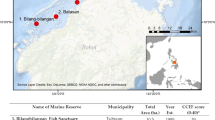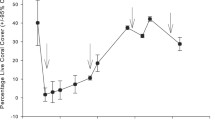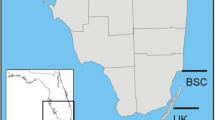Abstract
Colony size is an important life-history characteristic of corals and changes in colony size will have significant effects on coral populations. This study summarizes ∼21,000 haphazard colony size measurements of 26 common coral taxa (mostly coral genera) collected annually between 1992 and 2006 in seven Kenyan reef lagoons. There was a major coral bleaching and mortality event in early 1998 and all seven reefs were affected. The seven locations include two long-protected Marine National Parks (Malindi and Watamu), one relatively recently established park (Mombasa), and four unprotected locations (Vipingo, Kanamai, Ras Iwatine, and Diani). They span about 150 km and represent three distinct fishery management regimes: old protected (OP), newly protected (NP), and unprotected (UP). Seventeen taxa had statistically significant different sizes for comparisons of the management regimes, with only one genus, Pavona, having larger sizes in the unprotected reefs. The size of eight coral genera showed a significant time and management interaction, and size frequency differences that existed in management areas prior to 1998 were further increased after the bleaching event. Time alone was a significant factor for eleven genera, and in all cases colonies were smaller after 1998. For most taxa, colony size distributions were significantly skewed and had right-tailed distributions. After 1998, the right-tailed distributions of Acropora, Hydnophora, and Montipora were significantly reduced. Most taxa had peaky distributions and only Acropora experienced a statistically significant change from peaky to flat. The mean sizes of taxa were not related to their mortality across 1998, which indicates that the size effect was within rather than between taxa. Astreopora and Platygyra were well-sampled taxa that did not show an effect of management, but had reduced median sizes across 1998. Consequently, no taxa were tolerant of both fishing and bleaching disturbances and the combined effect was to reduce the size of all corals.






Similar content being viewed by others
References
Aronson RB, Precht WF (2006) Conservation, precaution, and Caribbean reefs. Coral Reefs 25:441–450
Baird AH, Marshall PA (2002) Mortality, growth and reproduction in scleractinian corals following bleaching on the Great Barrier Reef. Mar Ecol Prog Ser 237:133–141
Bak RPM, Meesters EH (1998) Coral population structure: the hidden information of colony size–frequency distributions. Mar Ecol Prog Ser 162:301–306
Bak RPM, Meesters EH (1999) Population structure as a response of coral communities to global change. Amer Zool 39:56–65
Belgrano A, Brown JH (2002) Oceans under the macroscope. Nature 419:128–129
Bellwood DR, Hughes TP, Folke C, Nystrom M (2004) Confronting the coral reef crisis. Nature 429:827–832
Bena C, van Woesik R (2002) The impact of two bleaching events on the survival of small coral colonies (Okinawa, Japan). Bull Mar Sci 75:115–125
Brown JH (1995) Macroecology. The University of Chicago Press, Chicago
Cros A, McClanahan TR (2003) Coral transplant damage under various management conditions in the Mombasa Marine National Park, Kenya. West Ind Ocean J Mar Sci 2:127–136
Diaz-Pulido G, McCook LJ (2002) The fate of bleached corals: patterns and dynamics of algal recruitment. Mar Ecol Prog Ser 232:115–128
Donohue MJ, Boland RC, Sramek CM, Antonelis GA (2001) Derelict fishing gear in the Northwestern Hawaiian Islands: diving surveys and debris removal in 1999 confirm threat to coral reef ecosystems. Mar Pollut Bull 42:1301–1312
Fong P, Glynn PW (1998) A dynamic size-structured population model: does disturbance control size structure of a population of the massive coral Gardineroseris panulata in the Eastern Pacific? Mar Biol 130:663–674
Fong P, Glynn PW (2001) Population abundance and size–structure of an eastern tropical Pacific reef coral after the 1997–98 ENSO: a simulation model predicts field measures. Bull Mar Sci 69:187–202
Gates RD, Edmunds PJ (1999) The physiological mechanisms of acclimatization in tropical reef corals. Am Zool 39:30–43
Glassom D, Zakai D, Chadwick-Furman NE (2004) Coral recruitment: a spatio-temporal analysis along the coastline of Eilat, northern Red Sea. Mar Biol 144:641–651
Glynn PW, Colley SB, Ting JH, Mate JL, Guzman HM (2000) Reef coral reproduction in the eastern Pacific: Costa Rica, Panama and Galapagos Islands (Ecuador). IV. Agaricidae, recruitment and recovery of Pavona varians and Pavona sp. A. Mar Biol 136:785–805
Hall VR, Hughes TP (1996) Reproductive strategies of modular organisms: comparative studies of reef-building corals. Ecology 77:950–963
Hughes TP (1984) Population dynamics based on individual size rather than age: a general model with a reef coral example. Am Nat 123:778–795
Hughes TP (1989) Community structure and diversity of coral reefs: the role of history. Ecology 70:275–279
Hughes TP, Connell JH (1987) Population dynamics based on size or age? A reef-coral analysis. Am Nat 129:818–829
Hughes TP, Tanner JE (2000) Recruitment failure, life histories, and long-term decline of Caribbean corals. Ecology 81:2250–2263
Karlson RH (1986) Disturbance, colonial fragmentation, and size-dependent life history variation in two coral reef cnidarians. Mar Ecol Prog Ser 28:245–249
Karlson RH (1988) Size-dependent growth in two zoanthid species: a contrast in clonal strategies. Ecology 69:1219–1232
LaBarbera M (1989) Analyzing body size as a factor in ecology and evolution. Ann Rev Ecol Syst 20:97–117
Lemmens JWTJ (1993) Reef-building corals (Cnidaria: Scleractinia) from the Watamu marine national reserve, Kenya: an annotated species list. Zool Med Leiden 67:453–465
Loya Y, Sakai K, Yamazato K, Nakano Y, Sambali H, van Woesik R (2001) Coral bleaching: the winners and the losers. Ecol Lett 4:122–131
McClanahan TR (2002) The near future of coral reefs. Environ Conserv 29:460–483
McClanahan TR (2004) The relationship between bleaching and mortality of common corals. Mar Biol 144:1239–1245
McClanahan TR, Mutere JC (1994) Coral and sea urchin assemblage structure and interrelationships in Kenyan reef lagoons. Hydrobiologia 286:109–124
McClanahan TR, Mangi S (2001) The effect of closed area and beach seine exclusion on coral reef fish catches. Fish Manage Ecol 8:107–121
McClanahan TR, Shafir SH (1990) Causes and consequences of sea urchin abundance and diversity in Kenyan coral reef lagoons. Oecologia 83:362–370
McClanahan TR, Muthiga NA, Kamukuru AT, Machano H, Kiambo RW (1999) The effects of marine parks and fishing on coral reefs of northern Tanzania. Biol Cons 89:161–182
McClanahan TR, Muthiga NA, Mangi S (2001) Coral and algal changes after the 1998 coral bleaching: Interaction with reef management and herbivores on Kenyan reefs. Coral Reefs 19:380–391
McClanahan TR McLaughlin SM, Davy JE, Wilson WH, Peters EC, Price KL, Maina J (2004a) Observations of a new source of coral mortality along the Kenyan coast. Hydrobiologia 530/531:469–479
McClanahan TR, Baird AH, Marshall PA, Toscano MA (2004b) Comparing bleaching and mortality responses of hard corals between southern Kenya and the Great Barrier Reef, Australia. Mar Pollut Bull 48:327–335
McClanahan TR, Maina J, Herron-Perez P, Dusek E (2005) Detriments to post-bleaching recovery of corals. Coral Reefs 24:230–246
McClanahan TR, Ateweberhan M, Sebastian CR, Graham NAJ, Wilson SK, Guillaume MMM, Bruggemann JH (2007a) Western Indian Ocean coral communities: bleaching responses, and susceptibility to extinction. Mar Ecol Prog Ser 337:1–13
McClanahan TR, Graham NAJ, Calnan JM, MacNeil MA (2007b) Towards pristine biomass: reef fish recovery in coral reef marine protected areas in Kenya. Ecol Appl 17:1055–1067
McCook LJ, Jompa J, Diaz-Pulido G (2001) Competition between corals and algae on coral reefs: a review of evidence and mechanisms. Coral Reefs 19:400–417
Meesters EH, Wesseling I, Bak RPM (1996) Partial mortality in three species of reef-building corals and the relation with colony morphology. Bull Mar Sci 58:838–852
Meesters EH, Pauchli W, Bak RPM (1997b) Predicting regeneration of physical damage on a reef-building coral by regeneration capacity and lesion shape. Mar Ecol Prog Ser 146:91–99
Meesters EH, Wesseling I, Bak RPM (1997a) Coral colony tissue damage in six species of reef-building corals: partial mortality in relation with depth and surface area. J Sea Res 37:131–144
Meesters EH, Hilterman M, Kardinaal E, Keetman M, de Vries M, Bak RPM (2001) Colony size frequency distributions of scleractinian coral populations: spatial and interspecific variation. Mar Ecol Prog Ser 209:43–54
Mumby PJ (1999) Bleaching and hurricane disturbances to populations of coral recruits in Belize. Mar Ecol Prog Ser 190:27–35
Mumby PJ, Harborne AR, Williams J, Kappel CV, Brumbaugh DR, Micheli F, Holmes KE, Dahlgren CP, Paris CB, Blackwell PG (2007) Trophic cascade facilitates coral recruitment in a marine reserve. Proc Natl Acad Sci USA 104:8362–8367
Nakamura T, van Woesik R (2001) Differential survival of corals during the 1998 bleaching event is partially explained by water-flow rates and passive diffusion. Mar Ecol Prog Ser 212:301–304
Nugues MM, Roberts CM (2003a) Partial mortality in massive reef corals as an indicator of sediment stress on coral reefs. Mar Poll Bull 46:314–323
Nugues MM, Roberts CM (2003b) Coral mortality and interaction with algae in relation to sedimentation. Coral Reefs 22:507–516
Rodgers KS, Cox EF (2003) The effects of trampling on Hawaiian corals along a gradient of human use. Biol Conserv 112:383–389
Ruesink JL (1997) Coral injury and recovery: matrix models link process to pattern. J Exp Mar Biol Ecol 210:187–208
Sall J, Lehmaan A, Creighton L (2001) JMP start statistics, 2nd edn. Thomson Learning, Duxbury
Shenkar N, Fine M, Loya Y (2005) Size matters: bleaching dynamics of the coral Oculina patagonica. Mar Ecol Prog Ser 294:181–188
Sokal PR, Rohlf FJ (1995) Biometry, 3rd edn. Freeman and Co., San Francisco
Tabachnick BG, Fidell LS (1996) Using multivariate statistics, 3rd edn. Harper Collins, New York
Veron J (2000) Corals of the World, 1st edn. Australian Institute of Marine Science, Townsville
Wielgus J, Chadwick-Furman NE, Dubinsky Z (2004) Coral cover and partial mortality on anthropogenically impacted coral reefs at Eilat, northern Red Sea. Mar Pollut Bull 48:248–253
Wilson SK, Graham NAJ, Pratchett MS, Jones GP, Polunin NVC (2006) Multiple disturbances and the global degradation of coral reefs: are reef fishes at risk or resilient? Global Change Biol 12:2220–2234
Yap HT, Gomez ED (1988) Aspects of benthic recruitment on a northern Philippine reef. Proc 6th Int Coral Reef Symp 2:279–283
Acknowledgments
Research was supported by the Wildlife Conservation Society through a number of sources; USAID’s Program in Science in Technology, Eppley, McBean, Perretti, Stebbins Foundations, the Pew Charitable Trust, and the World Bank Coral Reef Targeted Research Program on coral bleaching. Fieldwork was assisted by a number of collaborators including H. Machano Ali, B. Kaunda-Arara, R. Arthur, A.T. Kamukuru, R. Moothien-Pillay, S. Mangi, N.A. Muthiga, H. Peters, and M.J. Rodriques. N.A. Muthiga read and improved the manuscript. Permission to undertake research was granted by Kenya’s Office of Science and Technology and Kenya Wildlife Services.
Author information
Authors and Affiliations
Corresponding author
Additional information
Communicated by J.P. Grassle.
Appendix
Appendix
Rights and permissions
About this article
Cite this article
McClanahan, T.R., Ateweberhan, M. & Omukoto, J. Long-term changes in coral colony size distributions on Kenyan reefs under different management regimes and across the 1998 bleaching event. Mar Biol 153, 755–768 (2008). https://doi.org/10.1007/s00227-007-0844-4
Received:
Accepted:
Published:
Issue Date:
DOI: https://doi.org/10.1007/s00227-007-0844-4




